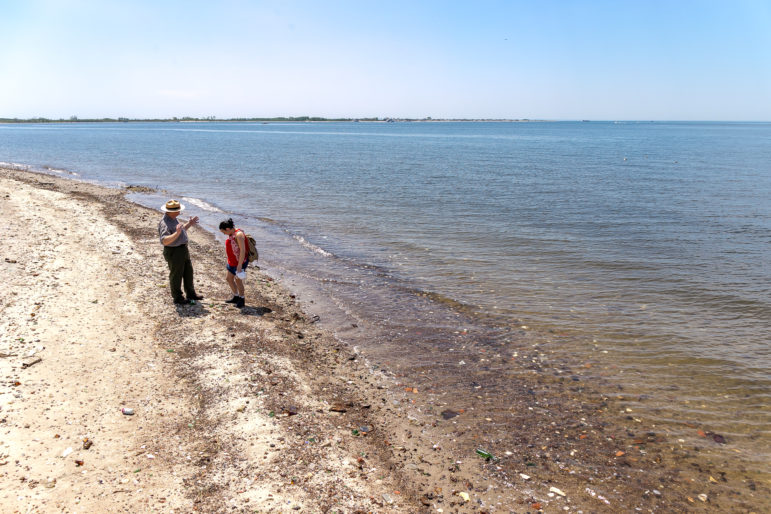“We already have large-scale natural areas across the city,” said Annel Hernandez, associate director of the New York City Environmental Justice Alliance. “But there is a mismatch with that and the number of jobs that are focused on this sector.”

Adi Talwar
A National Park Ranger speaks with a visitor on the shore of Brooklyn’s Bottle Beach in 2017.With increased incidents of deadly heat waves and extreme storms, city and state officials are turning to nature-based solutions to combat the effects of climate change.
This shift is increasing the need for nature-based jobs, according to a recently-released report, but few such dedicated jobs exist in New York City. This represents a largely untapped sector that, if developed properly, could bring quality employment opportunities to more New Yorkers, the report’s authors say. The Biden Administration on Friday announced disappointing national job growth in November; the city’s unemployment rate was 8.4 percent in October, the most recent month for which data is available—the highest of ant region in the state.
The report, prepared by Just Nature NYC, a partnership between the New York City Environmental Justice Alliance and The Nature Conservancy in New York, sought to identify currently existing nature-based jobs—gigs that employ people in caring for the city’s green spaces, urban forest and waterfront. These positions became more crucial during COVID-19, when New Yorkers relied more on outdoor space, and will be key to protecting city residents from the effects of climate change, the report said.
“We already have large-scale natural areas across the city,” said Annel Hernandez, associate director of the New York City Environmental Justice Alliance. “But there is a mismatch with that and the number of jobs that are focused on this sector.”
“To compound that, we know that we are going to need to invest a lot more deeply on climate resiliency, and all of these different types of nature-based solutions,” Hernandez added.
The report’s analysis tallied there being some 45,560 jobs in the city last year in a dozen nature-based positions such as landscape architects, construction managers and tree trimmers and pruners. It noted projected growth for each role between 2020 and 2025, with the most expected growth to be in the professions of soil and plant scientists (expected to grow by 41 percent) and conservation scientists (with a growth of 27 percent).
Still, those projections are falling short of what the City needs to properly maintain its green infrastructure, said Emily Nobel Maxwell of The Nature Conservancy.
New York City has more than 30,000 acres of parks, 520 miles of coastline—the use of which is being analyzed by the city for its forthcoming waterfront plan—and more than 5,650 acres of wetlands, according to the report. Still, there remains a need for additional green space, especially in environmental justice communities, which are plagued with heat islands and lack of recreational space. A report this summer by American Forests found that New York City would need to add 1.5 million trees in order to provide equitable distribution of tree cover across every neighborhood.
Positions that would care for these ecosystems have in some cases decreased or experienced slow growth, the report says. While the number of tree trimmers and pruners has grown by 92 percent between 2015 and 2020, the number of landscaping and groundskeeping jobs have decreased, leaving fewer than 10,000 workers to steward those spaces, data showed.
Jobs involving the planning and conceptualizing of green spaces are growing, but slowly. In that same period, positions for landscape architects, soil and plant scientists as well as urban and regional planners grew at a rate of less than 15 percent. Hydrologist positions decreased by 14 percent.
Most notably, there was a large gap in the number of foresters available to maintain the city’s urban forest, which covers 22 percent of New York City’s landscape. Those positions, which decreased by 42 percent in 2020, are projected to grow from 30 to about 36 by 2025, according to data analyzed in the report. “I think clearly we’re going to need a lot more workers than 30 foresters,” said Hernandez.
Another gap in this sector is in diversity and advancement opportunities. Much of the positions within the construction and maintenance categories, which are often filled by Black and Latinx workers, are seasonal or temporary and have limited career growth, the report notes.
By partnering with the New York City Environmental Justice Alliance, public and private entities can promote equitable and local hiring as well as training and advancement opportunities. “If we’re doing a project in the community, you know, ranging from a green roof to solar on your rooftop, local hiring has to be at the center of that,” said Hernandez.
Pathways to these jobs are also limited. For instance, no public or private city-based institution offers a dedicated forestry degree, according to the report. There are fewer than 100 foresters in the city, making less than the national average, the study noted.
“It’s not only about hiring locally, but it’s also about training and supporting locally,” said Nobel Maxwell. “It’s tremendously important that these jobs are paid a truly living wage for New York City.”
The report also showed that some jobs that include nature-based responsibilities do not designate those as a priority. For example, the City’s Housing Authority is under-resourced in its ability to care for green spaces, according to Siobhan Watson, a NYCHA program manager quoted in the report.
“NYCHA caretaker’s jobs are partially nature-based, but with limited staffing, their ability to put time into caring for the landscape comes after other responsibilities like waste removal,” she said.
The city has already begun making heavy investments in nature-based climate solutions, suggesting a growing need for these kinds of positions in the immediate future.
Last week, the Office of Environmental Protection announced it would transform concrete medians in Queens into green spaces as a way to better manage stormwater; such “natural drainage spaces” can also help to reduce the effect of heat islands and energy demand. Maintenance of such spaces, along with rain gardens and other green infrastructure, should lead to increased hires by the Department of Environmental Preservation in coming years, the jobs report notes.
In October, the City Council approved a measure that will lead to the formation of a task force to create a climate resiliency plan for all five boroughs by September of 2022, and each 10 years thereafter. In the same meeting, the Council approved a bill creating an Office of Urban Agriculture to promote community gardens and other greening models, like urban farms, to address food insecurity, an issue that’s become more widespread during the COVID-19 pandemic.
These changes, along with a new incoming mayor, Eric Adams—who has pledged to promote an agrarian economy once in office—provide an opportunity for the city to invest more significantly in this sector.
“We hope that this report can help [the Adams administration] as they think about climate resilience to think not only about the infrastructure side, which is critical, but also what are the associated investments that need to be made in the workforce side to really ensure that that resilience vision is achieved,” said Nobel Maxwell.
“New York City has a long way to go to recover from the last two years,” said Hernandez. “And these types of jobs can be one of the areas where we can grow in.”
Liz Donovan is a Report for America corps member.









